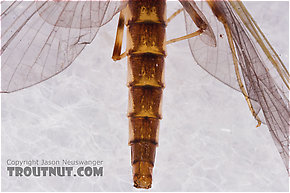Blog & Latest Updates
Fly Fishing Articles
Insects by Common Name


> > Spinadis simplex
The Specimen
Heptageniidae (March Browns, Cahills, Quill Gordons) Mayfly Dun View 10 PicturesThis specimen is really strange, very different in form from any other mayfly I've seen. Unfortunately it was found alone crippled in an eddy and in pretty bad shape, and I couldn't find any others like it.
View 10 PicturesThis specimen is really strange, very different in form from any other mayfly I've seen. Unfortunately it was found alone crippled in an eddy and in pretty bad shape, and I couldn't find any others like it.
 View 10 PicturesThis specimen is really strange, very different in form from any other mayfly I've seen. Unfortunately it was found alone crippled in an eddy and in pretty bad shape, and I couldn't find any others like it.
View 10 PicturesThis specimen is really strange, very different in form from any other mayfly I've seen. Unfortunately it was found alone crippled in an eddy and in pretty bad shape, and I couldn't find any others like it.Collected June 28, 2005 from the Long Lake Branch of the White River in Wisconsin
Added to Troutnut.com by on May 26, 2006
Added to Troutnut.com by on May 26, 2006
The Discussion
| Taxon | July 19th, 2019, 11:10 pm | |
Site Editor Royse City, TXPosts: 1350 | Hi Jason- I believe this female to be a spinner, rather than a dun, and is probably Spinadus simplex. | |
| Best regards, Roger Rohrbeck www.FlyfishingEntomology.com | ||
| Troutnut | July 20th, 2019, 7:21 am | |
Administrator Bellevue, WAPosts: 2737 | Hi Roger, That's an interesting guess and certainly seems to match the general body profile well. However, the color patterns on both the tergites and sternites are very different from those in the Spinadis simplex specimen you uploaded to bugguide.net earlier this year: https://bugguide.net/node/view/1634542/bgimage Another page on there led to this paper describing the first adult of Spinadis simplex: http://www.ephemeroptera-galactica.com/pubs/pub_m/pubmccaffertyw1984p173.pdf This characteristic seems especially relevant in the description of S. simplex, and doesn't seem to match this specimen: "The fore tibia is approximately three times as long as the tarsus, and one-third the length of the femur." Another important one is, "The hind tibia is 1.16 times the femur length." They note this is also present to some extent in the nymphs. Also, the shape of the subanal plate is pretty different and is noted as a valuable characteristic. The paper also extensively describes the characteristics of an enlarged pronotum in S. simplex that doesn't seem to be present in this one. Finally, the habitat is very different; this came from a smalls stream distant from any of the large rivers previously described as Spinadis habitat. I still think this is a dun -- the wings are quite pale for a dun but not really hyaline like a spinner. My early photography didn't make this particularly easy to tell, but you can also make out setae on the margins of the wings in this picture. The dun-spinner difference might explain some other differences including the leg proportions, but I think enough characteristics differ that it's probably not S. simplex. | |
| Jason Neuswanger, Ph.D. Troutnut and salmonid ecologist | ||
Quick Reply
You have to be logged in to post on the forum. It's this easy:
Related Discussions
Troutnut.com is copyright © 2004-2024 Jason
Neuswanger (email Jason). See my FAQ for information about use of my images.
 privacy policy
privacy policy


